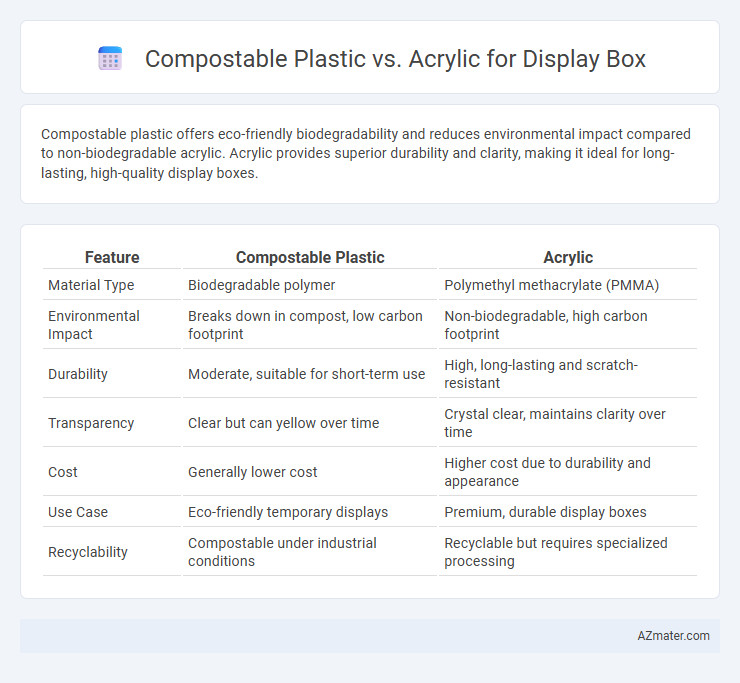Compostable plastic offers eco-friendly biodegradability and reduces environmental impact compared to non-biodegradable acrylic. Acrylic provides superior durability and clarity, making it ideal for long-lasting, high-quality display boxes.
Table of Comparison
| Feature | Compostable Plastic | Acrylic |
|---|---|---|
| Material Type | Biodegradable polymer | Polymethyl methacrylate (PMMA) |
| Environmental Impact | Breaks down in compost, low carbon footprint | Non-biodegradable, high carbon footprint |
| Durability | Moderate, suitable for short-term use | High, long-lasting and scratch-resistant |
| Transparency | Clear but can yellow over time | Crystal clear, maintains clarity over time |
| Cost | Generally lower cost | Higher cost due to durability and appearance |
| Use Case | Eco-friendly temporary displays | Premium, durable display boxes |
| Recyclability | Compostable under industrial conditions | Recyclable but requires specialized processing |
Introduction to Display Box Materials
Display boxes crafted from compostable plastic offer an eco-friendly alternative to traditional acrylic, utilizing biodegradable polymers such as polylactic acid (PLA) that break down naturally under industrial composting conditions. Acrylic, known scientifically as polymethyl methacrylate (PMMA), provides superior clarity, durability, and weather resistance, making it a popular choice for long-lasting and visually striking display cases. The choice between compostable plastic and acrylic balances environmental sustainability with performance characteristics like transparency, rigidity, and lifecycle impact.
What is Compostable Plastic?
Compostable plastic is a biodegradable material designed to break down into natural elements within a specific timeframe under composting conditions, minimizing environmental impact. Unlike acrylic, which is derived from petroleum and is non-biodegradable, compostable plastic offers eco-friendly benefits by decomposing into organic matter without leaving harmful residues. This makes compostable plastic an ideal choice for display boxes aimed at reducing plastic waste and supporting sustainability initiatives.
Understanding Acrylic: Properties and Uses
Acrylic, a lightweight and durable thermoplastic known for its exceptional clarity and weather resistance, is widely used in display boxes to showcase products while providing strong protection. Its high impact resistance and UV stability make it ideal for both indoor and outdoor displays, maintaining transparency without yellowing over time. Acrylic's versatility allows for easy fabrication, including cutting, shaping, and polishing, making it a preferred material in retail and exhibition settings.
Environmental Impact: Compostable Plastic vs Acrylic
Compostable plastic display boxes significantly reduce environmental impact by breaking down naturally within months under industrial composting conditions, minimizing long-term waste and pollution. Acrylic, a non-biodegradable petroleum-based plastic, persists in landfills for centuries, contributing to microplastic contamination and fossil fuel depletion. Choosing compostable plastic supports sustainable waste management and lowers carbon footprint compared to acrylic's energy-intensive production and disposal challenges.
Durability and Longevity Comparison
Compostable plastic display boxes offer eco-friendly benefits but typically lack the durability and longevity of acrylic counterparts, as they may degrade or weaken faster under prolonged exposure to moisture and UV light. Acrylic display boxes provide superior resistance to impact, scratches, and environmental factors, ensuring long-lasting clarity and structural integrity, making them ideal for premium and repeated-use displays. While compostable plastics align with sustainability goals, acrylic materials excel in maintaining consistent durability and visual appeal over time.
Aesthetic Appeal: Visual Differences
Compostable plastic display boxes offer a matte, natural finish that complements eco-friendly branding with subtle, earthy tones, often exhibiting slight texture variations that highlight sustainability. Acrylic display boxes provide a high-gloss, crystal-clear surface with exceptional transparency and smoothness, enhancing the vibrancy and sharpness of showcased products. The visual difference lies in compostable plastic's organic, less reflective appearance versus acrylic's sleek, polished look ideal for premium displays.
Cost Analysis: Initial and Long-Term Expenses
Compostable plastic display boxes typically incur higher initial production costs due to specialized raw materials and manufacturing processes compared to acrylic, which benefits from established mass production economies. Over the long term, compostable plastics can reduce waste disposal expenses and environmental fees, potentially lowering total lifecycle costs despite maintenance challenges. Acrylic display boxes, while cost-effective upfront, may require frequent replacements and generate higher environmental disposal impacts, influencing long-term financial considerations.
Disposal and End-of-Life Considerations
Compostable plastic display boxes break down naturally in industrial composting facilities within 90 to 180 days, reducing landfill waste and lowering environmental impact through biodegradation. Acrylic display boxes, made from non-biodegradable polymethyl methacrylate, persist in landfills for centuries and require energy-intensive recycling processes that are less widely available. Choosing compostable plastics supports circular economy goals by enabling organic waste streams, while acrylic demands specialized disposal methods that limit sustainability.
Suitability for Retail and Exhibits
Compostable plastic offers an eco-friendly alternative with biodegradability that appeals to sustainability-focused retail brands but may lack the durability and clarity of acrylic, which provides superior transparency and rigidity ideal for high-end displays and long-term exhibits. Acrylic's resistance to impact, UV light, and moisture ensures vibrant product presentation and longevity, making it suitable for environments requiring repeated use and visual appeal. Compostable plastic suits temporary or short-term displays prioritizing environmental impact, while acrylic remains the preferred choice for premium retail showcases demanding durability and aesthetic excellence.
Choosing the Right Material for Your Display Box
Choosing the right material for your display box depends on factors such as durability, environmental impact, and aesthetic appeal. Compostable plastics offer eco-friendly benefits with biodegradability, making them ideal for sustainable branding, while acrylic provides superior clarity, strength, and longevity for premium displays. Evaluate product lifespan requirements and brand values to balance environmental responsibility with functional performance when selecting between compostable plastic and acrylic.

Infographic: Compostable plastic vs Acrylic for Display box
 azmater.com
azmater.com